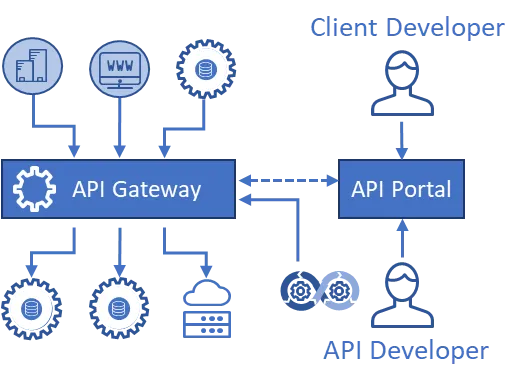Establishing Common Ground: Key API Concepts for Strategic Alignment
When defining or advancing an API strategy, it’s critical that both IT and business stakeholders share a clear understanding of core API concepts. Aligning on terminology and architectural patterns helps eliminate ambiguity, streamline communication, and enable more effective decision-making.
What is an API?
An Application Programming Interface (API) is more than a technical connector—it’s a digital contract that defines how different software components interact. APIs expose data and functionality securely, enabling reuse across applications, channels, and even enterprises.
In essence, APIs provide abstraction. They hide complexity and offer standardized interfaces for services that can range from customer onboarding to payment processing.
A well-designed API reduces time-to-market, supports interoperability, and enables integration across diverse technology stacks. It is the building block of composable architecture and a cornerstone of digital transformation.
As organizations move toward digital ecosystems, APIs become the connective tissue enabling collaboration, monetization, and innovation at scale.
REST and Microservices Architecture
REST (Representational State Transfer) is the dominant architectural style for web APIs. It is stateless, resource-oriented, and based on a uniform interface using HTTP methods like GET, POST, PUT, and DELETE. REST promotes scalable, loosely coupled systems with discoverable endpoints.
RESTful APIs are the backbone of many enterprise microservices, which break applications into independently deployable units. This fosters agility, fault tolerance, and continuous delivery.
Together, REST and microservices support modular business capabilities, allowing organizations to iterate faster and respond to change with minimal disruption.
API-First and API-as-a-Product
The API-First philosophy reorients how software systems are designed, shifting the focus from internal application logic to external interaction and integration. Rather than treating APIs as byproducts of application development, this approach puts API design at the center of the software lifecycle.
In an API-First model, teams begin by collaboratively defining API contracts—clear, documented specifications for how services will communicate—before writing any backend or frontend code. This contract becomes the source of truth for both producers and consumers, enabling front-end developers, backend engineers, product teams, and external partners to work in parallel without dependencies or guesswork.
Strategic Benefits of API-First
- Enables Parallel Development: Clear API contracts allow multiple teams to build independently against the same interface, accelerating velocity and minimizing blockers.
- Drives Consistency: Centralized design governance and reusable schemas reduce duplication and ensure API uniformity across the enterprise.
- Improves Developer Experience (DX): Well-documented, thoughtfully designed APIs reduce friction for internal and external developers alike.
- Facilitates Governance: Defining contracts early enables integration of policy checks, style validation, and version control into CI/CD workflows.
API-First is a cornerstone for organizations seeking agility, scalability, and ecosystem readiness. It forms the foundation for more advanced practices like platform engineering, event-driven architectures, and internal developer portals.
Treating APIs as Products
API-as-a-Product goes a step further—elevating APIs from technical utilities to strategic offerings. This means managing APIs like any customer-facing product, complete with a value proposition, roadmap, customer support model, and performance KPIs.

Characteristics of an API Product
- Defined Consumer Personas: APIs are built with a specific audience in mind—whether internal developers, external partners, or third-party innovators.
- Clear Business Value: Each API exists to enable a use case, solve a problem, or unlock a revenue stream—not just expose data.
- Service-Level Agreements (SLAs): Expectations around uptime, latency, and support are documented and measurable.
- Versioning Strategy: Like any product, APIs evolve. Productized APIs maintain backward compatibility and communicate changes transparently.
- Usage Analytics and Feedback Loops: Monitoring, analytics, and developer feedback inform roadmap decisions and iterative improvement.
API-as-a-Product thinking ensures that APIs are treated as assets to be curated, promoted, and evolved—just like any other digital product in your portfolio.
Enabling Ecosystem Growth
When APIs are designed with purpose and managed with a product mindset, they unlock exponential value:
- Accelerate Digital Transformation: APIs expose core capabilities for reuse across lines of business, reducing redundancy and time-to-market.
- Power Ecosystem Innovation: Partners and third-party developers can build on top of your APIs, extending your platform’s reach and functionality.
- Drive Monetization: Tiered access models, pay-per-use pricing, and value-added services create new revenue streams.
- Enhance Resilience and Scalability: Productized APIs are robust, well-documented, and governed—resulting in greater reliability and developer trust.
Ultimately, API-First ensures that your APIs are well-architected and consistent. API-as-a-Product ensures that they are valuable, consumable, and strategically aligned. Together, these approaches position APIs as central assets in your digital transformation strategy—not just middleware, but key drivers of business innovation and growth.
Design-First and the OpenAPI Standard
Design-First development involves creating API specifications collaboratively with stakeholders before implementation. It prioritizes clarity, customer experience, and reusability.
This method minimizes rework, simplifies documentation, and streamlines integration.
Model-driven design complements design-first by using shared models to generate APIs, events, and data schemas. It encourages cross-functional collaboration and domain-driven thinking.
The OpenAPI Specification (OAS) serves as the lingua franca for HTTP APIs. With robust tooling support, it facilitates everything from code scaffolding to automated testing—accelerating time-to-value for API initiatives.
The Role of the API Gateway
An API Gateway functions as the central router, security guard, and traffic controller for APIs. It abstracts backend services and presents a unified interface to consumers.
Gateways handle authentication, authorization, rate-limiting, caching, request transformation, and traffic shaping.

They reduce complexity for backend teams and provide observability to operations teams. By enforcing policies centrally, API gateways ensure scalability and compliance with organizational standards.
What is API Management?
API Management refers to the comprehensive set of processes, tools, and practices that govern the full lifecycle of APIs—from design and publication to monitoring, retirement, and everything in between. It’s not simply about routing traffic or enforcing authentication at an API gateway. True API management is about ensuring APIs deliver value securely, consistently, and in alignment with business strategy.
In today’s digital-first enterprises, APIs are not just technical artifacts — they are products, platforms, and operational lifelines. API management platforms therefore serve as the operational backbone that enables these interfaces to scale responsibly and effectively.
Core Capabilities
Modern API management platforms offer a wide array of core capabilities, including:
-
API Publication & Versioning
Allows developers to register, document, and version APIs for consumption in a controlled, discoverable manner. -
Security & Policy Enforcement
Centralized management of authentication, authorization, rate-limiting, threat protection (e.g., schema validation, SQL injection mitigation), and more. -
Developer Onboarding & Portal Integration
Facilitates a seamless self-service experience through an API portal, including automated access workflows, documentation, SDKs, and sandbox environments. -
Monitoring & Analytics
Provides real-time and historical insights into API usage, error rates, latency, consumer behavior, and SLA adherence. This enables optimization and early detection of issues. -
Lifecycle Management
Supports the governance of APIs through defined lifecycle stages such as design, publish, deprecate, and retire — allowing teams to manage change effectively without disrupting consumers. -
Quota & Subscription Management
Enforces usage limits based on plans, consumers, or tiers, and integrates with monetization models when applicable.
Organizational Benefits
A mature API management platform enables enterprise-wide alignment and operational excellence. It delivers value across different personas and teams:
-
For Development Teams:
Empowers decentralized, autonomous teams to rapidly build and deploy APIs within a framework of shared tooling, observability, and guardrails — accelerating time-to-market while maintaining consistency. -
For Product Managers:
Provides visibility and control over API adoption, usage patterns, and consumer feedback. Enables iterative improvement of APIs as products, with lifecycle metrics to inform investment decisions. -
For Security & Compliance Teams:
Ensures that every API adheres to enterprise security policies, regulatory mandates, and internal governance frameworks — with audit trails, logging, and policy-as-code enforcement.
Bridging Autonomy and Control
Perhaps the most critical role of API management is bridging the often conflicting goals of developer speed and enterprise control. On one side, you need to empower teams to move fast, innovate, and deliver services independently. On the other, you must maintain visibility, ensure security, and enforce standards across a growing and decentralized API landscape.
API management platforms resolve this tension by offering a federated model — giving teams autonomy within clearly defined governance zones. This enables agility at the edge with control at the core.
API Portal and API Catalog
An API Portal serves as the front door to your API ecosystem—a centralized, self-service interface where developers can discover, understand, and interact with your API offerings. Much like a digital storefront, an API portal showcases the enterprise’s digital capabilities, making it easy for consumers—whether internal developers, partners, or external innovators—to find and integrate the services they need.
Well-designed API portals don’t just publish documentation—they create an engaging and productive developer experience (DX), enabling rapid onboarding, feedback loops, and real-time support mechanisms. They are critical enablers for adoption, scale, and innovation in any API strategy.
Key Functions of an API Portal
An effective API portal typically includes:
-
Interactive API Documentation
Rich, browsable documentation that includes sample requests, expected responses, authentication details, and error codes. Often generated directly from OpenAPI specs and integrated with tools like Swagger UI or Redoc. -
SDKs and Code Samples
Prebuilt client libraries and code snippets in multiple languages reduce time-to-integration and minimize errors for common tasks. -
API Catalog & Search
A searchable catalog of available APIs, organized by business domain, use case, or consumer audience. Metadata such as tags, versioning, and lifecycle stage improve discoverability and governance. -
Authentication & Credential Management
Secure, guided workflows for requesting and managing API keys, OAuth tokens, or client certificates. Often includes granular permission scopes and rate-limit configurations. -
Try-It-Out Features & Mock APIs
Interactive consoles allow developers to test APIs directly in the browser, often powered by live sandbox environments or mocking tools. -
Rate Limit and Plan Transparency
Displays quota rules, access tiers, or monetization plans upfront to set expectations and drive proper usage patterns. -
Developer Registration & Support Channels
Enables consumer onboarding, account management, ticket submission, and community forums—transforming one-way documentation into two-way engagement.
Strategic Benefits
An API portal is more than a convenience—it’s a force multiplier for developer productivity and platform growth:
- Accelerates Adoption: Reduces time-to-first-call and shortens the integration lifecycle.
- Improves Governance: Standardizes how APIs are published, discovered, and consumed across business units.
- Enables Self-Service at Scale: Minimizes the support burden on platform teams by empowering users to help themselves.
- Drives Ecosystem Engagement: Encourages internal reuse, partner integrations, and third-party innovation by creating a transparent, developer-friendly interface to the enterprise.
Whether you’re scaling an internal developer platform, building a partner program, or monetizing APIs through a public marketplace, the API portal is the experience layer that brings your strategy to life. It’s where your APIs stop being artifacts—and start becoming assets.

An API Catalog is the authoritative registry of all API products and services available within an organization or exposed to its partners and external developers. Think of it as the API equivalent of a product catalog in retail—centralizing offerings, organizing them for consumption, and enabling easy discovery by potential users.
While often integrated with the API portal, the API catalog has a distinct purpose: to provide visibility, governance, and traceability across an ever-growing and evolving API ecosystem.
A mature API catalog doesn’t just list interfaces. It contextualizes each API within the broader enterprise landscape—answering critical questions such as:
- What does this API do, and which business capability does it represent?
- What is its current lifecycle status (e.g., draft, beta, production, deprecated)?
- Who owns it, and who is using it?
- What environments is it available in?
- What dependencies does it have, and what standards does it follow?

Key Functions of an API Catalog
An effective API catalog provides:
-
Comprehensive Discovery
Searchable metadata (tags, business domains, consumer roles) and filters (e.g., public/internal/partner APIs) that allow users to quickly find what they need without tribal knowledge or manual referrals. -
Lifecycle Visibility
Lifecycle tagging (design, build, live, deprecated, retired) helps consumers assess stability and readiness, and informs upgrade planning during version transitions. -
Ownership and Stewardship Information
Clear identification of API owners, teams, and support contacts enables faster onboarding, issue resolution, and SLA accountability. -
Governance Integration
Links to version-controlled OpenAPI specifications, documentation, testing reports, and conformance checks provide transparency and trustworthiness. -
Consumer Insights
Insights into usage history, consumer applications, and dependencies offer valuable context for managing change, avoiding regressions, and prioritizing investments. -
Onboarding Workflows
Integrated with access controls and approval mechanisms, allowing developers to request access, review terms of use, and begin building immediately.
Strategic Value of the API Catalog
A robust API catalog is not just a convenience—it’s an enabler of enterprise composability, API reuse, and innovation at scale.
-
Accelerates Time to Integration: Developers don’t waste cycles searching for who owns what. Instead, they discover, evaluate, and consume APIs on-demand.
-
Encourages Reuse Over Reinvention: When APIs are easily discoverable and trustworthy, teams are more likely to reuse existing solutions rather than build redundant ones from scratch.
-
Reduces Support Overhead: By reducing backchannel inquiries (“Does this already exist?”), the catalog alleviates burden on platform teams and centers of excellence.
-
Strengthens Governance and Security: Central visibility enables risk and compliance monitoring, anomaly detection, and enforcement of lifecycle policies.
-
Drives Cross-Domain Collaboration: APIs become building blocks that teams across business lines can leverage to co-create experiences, services, and platforms.
An API catalog is the nervous system of a digital enterprise’s API ecosystem. It transforms scattered assets into a curated, consumable, and governable product suite.
Effective API portals and catalogs reduce time to integration, minimize support overhead, and encourage reuse across business units.
The API Management Framework
A comprehensive API management framework brings cohesion to the various components of API infrastructure. It unites people, processes, and tools to enforce standards, drive adoption, and maintain quality.
The framework typically includes:
- CI/CD integration for versioning and automation
- DevOps pipelines for release orchestration
- Monitoring and alerting dashboards
- Policy libraries and governance checklists
It enables scalable innovation while preserving enterprise control.
Understanding the API Ecosystem
An API Ecosystem is the network of stakeholders, APIs, and enablers that power digital platforms. It includes:
- API producers and product teams
- Internal consumers across BUs
- External partners and developers
- Portals, gateways, and governance layers
The strength of an API ecosystem lies in its community engagement and the composability of its assets. A thriving ecosystem drives faster time-to-market, fosters collaboration, and reduces duplication.
API Governance
API Governance is the discipline of ensuring that all APIs across an organization are secure, standardized, well-documented, and aligned with business objectives. It provides structure without stifling creativity—ensuring that APIs evolve in a controlled, scalable, and trustworthy way.
As APIs multiply across business units and teams, the need for consistent design, reusable patterns, and enforceable quality checks becomes paramount. API governance fills this gap by offering a set of processes, principles, and tools that guide how APIs are designed, developed, deployed, and maintained.

Why Governance Matters
In a modern enterprise, APIs are no longer confined to the backend. They expose business capabilities externally, power digital experiences, connect ecosystems, and serve as integration points for partners and platforms. Without proper governance, this distributed architecture can quickly become fragmented, insecure, and unmanageable.
API governance helps mitigate this by:
- Driving consistency: Ensures every API adheres to shared design standards, naming conventions, error handling formats, and authentication mechanisms.
- Enforcing compliance: Helps satisfy internal and external regulations such as GDPR, HIPAA, or PCI DSS through standardized logging, encryption, and auditing practices.
- Enabling reuse: Promotes discoverability and avoids redundant development by mandating catalog publication and consistent metadata.
- Reducing risk: Protects against security misconfigurations, versioning conflicts, and accidental data exposure.
Modern Governance Practices
Contemporary API governance frameworks strike a balance between control and developer agility. They prioritize automation, transparency, and enablement over manual approvals and bureaucratic bottlenecks.
Key practices include:
-
Collaborative Design Reviews
Facilitate peer and architectural reviews during the design phase using shared documentation and modeling tools. This helps detect problems early and align APIs with domain-driven goals. -
Policy-as-Code Enforcement
Enforces governance standards automatically using CI/CD-integrated tools such as Spectral, OpenAPI validators, and security linters. This reduces the reliance on centralized oversight and makes conformance a default behavior. -
Style Guide Validation in Pipelines
Embeds enterprise API style guides (naming conventions, pagination, filtering, etc.) into automated checks during code commits and API spec updates. -
Transparent Lifecycle Management
Tracks each API through clearly defined stages—design, build, test, publish, deprecate, and retire. Tools like lifecycle dashboards and change logs ensure version integrity and consumer awareness.
A Federated Governance Model
Large organizations often adopt a federated governance model—where central teams define the guardrails, and domain teams operate autonomously within them. This model supports speed and innovation while maintaining enterprise-wide consistency.
Governance assets often include:
- A centralized API style guide
- Reference implementations and design patterns
- A design review board or architectural council
- Policy-as-code repositories and rule sets
- Approved tooling lists for spec validation, mocking, and testing
Empowering Developers While Reducing Risk
Effective API governance does not slow teams down—it accelerates them. When developers are equipped with clear guidelines, easy-to-use tooling, and automated feedback loops, they are more likely to build robust, compliant APIs from the outset.
Ultimately, governance is not about gatekeeping—it’s about scaling excellence. It ensures that every API your organization builds reflects your brand, protects your data, and creates value for consumers and partners alike.
Final Thoughts: From Interface to Impact
This overview has explored the essential concepts that shape effective API strategy, architecture, and governance. From foundational principles like REST and design-first thinking, to strategic enablers like API-as-a-product and enterprise governance frameworks, these concepts are more than just technical definitions—they are the vocabulary of digital transformation.
While the precise definitions and implementation details may vary across organizations and industries, alignment on these core principles is crucial. It ensures that API efforts are not siloed or fragmented, but are instead unified under a shared vision and operating model. This alignment creates clarity, fosters reuse, reduces friction, and enables teams to move with purpose and coordination.
Reframing APIs as Strategic Assets
To truly succeed in your API journey, you must move beyond treating APIs as technical plumbing. APIs are not incidental—they are the foundational building blocks of modern platforms, products, and partner ecosystems. They are:
- Business Enablers: Unlocking new digital revenue streams, enhancing customer experiences, and enabling data-driven services.
- Platform Accelerators: Allowing internal teams to innovate faster through modular, reusable services.
- Innovation Pathways: Powering collaboration across business units, partners, and developers in your extended ecosystem.
APIs are how companies scale their capabilities, extend their brand, and compete in an increasingly connected digital economy.
Principles for Sustainable Success
To translate API strategy into lasting value, enterprises must commit to a set of disciplined, forward-looking practices:
- Document Your Definitions: Ensure every team—from product to security to engineering—operates from a shared API vocabulary and reference model.
- Align Your Stakeholders: Involve business, IT, security, and developer communities early and often. Governance without collaboration is a dead end.
- Build with Purpose: Don’t build APIs for the sake of APIs. Prioritize those that align with business outcomes, ecosystem needs, and long-term strategic objectives.
- Design for Scale, Security, and Sustainability: Ensure that every API is designed with versioning, resilience, observability, and lifecycle management from the outset. Technical debt is easiest to avoid at design-time.
The organizations that thrive in the platform economy will be those that treat APIs as first-class citizens—investing in them with the same discipline and ambition as they would any flagship product.



